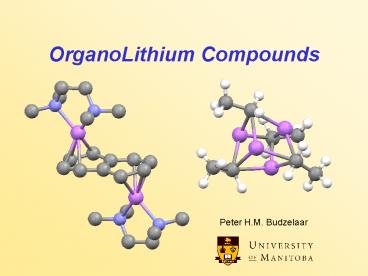OrganoLithium Compounds - PowerPoint PPT Presentation
1 / 20
Title:
OrganoLithium Compounds
Description:
used for. enantioselective. deprotonation. not all hydrogen positions. well-determined ... In laboratory: usually from alkyl bromides/iodides (easier to start) ... – PowerPoint PPT presentation
Number of Views:2588
Avg rating:3.0/5.0
Title: OrganoLithium Compounds
1
OrganoLithium Compounds
Peter H.M. Budzelaar
2
Organo-lithium compounds
- Ionic character, electron-deficient
- oligomeric or polymeric structures
- Strongly basic and nucleophilic
- applications in organic synthesis
- Reducing
- unwanted side reactions
3
Organo Na, K compounds
- "Purely" ionic
- polymeric structures
- pyrophoric solids
- mostly insoluble in any solvent they don't react
with - Very strong bases, not that good as nucleophiles
- few applications
- organoLi compounds are much easier to handle
4
Driving force for oligomerization
- ionic interpretation
Ionic interactions are "soft"but not weak!
5
Driving force for oligomerization
- covalent interpretation
2e-3c and 2e-4c bonds arenot just bonding
between Li and C,but also bonding between the Li
atoms
6
Structure of EtLi4
7
Structure of CyLi6
8
Structure of BuLi(THF)4
9
Structure of o-Me2NCH2C6H4Li4
10
Structure of 2,6-(MeO)2C6H3Li4
11
Structure of MeLi(sparteine)2
not all hydrogen positionswell-determined
used forenantioselectivedeprotonation
12
Structure of PhLi(pmdta)
13
Structure of (Allyl)Li(pmdta)
2.33
2.25
2.72
14
Structure of BzNa(pmdta)8
15
Structure of (Me3Si)3CRb8
16
Structure of (naphthalene)Li(tmeda)2
17
Synthesis of OrganoLi Compounds
- Direct synthesis
- Reactivity alkyl gt aryl, Cl lt Br lt I etc
- Commercial synthesis mostly from chlorides
- In laboratory usually from alkyl
bromides/iodides (easier to start) - Complication Li reacts with N2, do reaction
under Ar ! - Side reaction Wurtz coupling, especially for X
I - In apolar or weakly polar solvents
- Radical mechanism
- Transmetallation
- M less electropositive than Li
- Infrequently used
18
Reactions of OrganoLi Compounds
- Metallation
- Faster for more basic R-
- Faster in polar and/or coordinating solvents
- Works well if product capable ofintramolecular
coordination - Metal-halogen exchange
- Facile for I and Br, usually (too) slow for Cl, F
- Regioselective synthesis of R'Li
- Side reaction Wurtz coupling
- Usually done at low temperature (-80 to -20C)
19
Reactions of OrganoLi Compounds
- Metathesis
- Driving force stability of LiCl (lattice
energy!) - Selective synthesis of RlMXm often hard
- With excess RLi often "ate" complexes (Rn1M-)
20
Structure of (tmeda)LiMe22Mg































